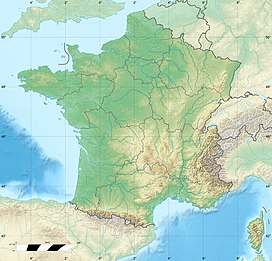Canigou
| Canigou | |
|---|---|
 A snow-capped Canigou across the Roussillon plain (December 2004). | |
| Highest point | |
| Elevation | 2,784 m (9,134 ft)[1] |
| Prominence | 550 m (1,800 ft) |
| Coordinates | 42°31′08″N 02°27′24″E / 42.51889°N 2.45667°E |
| Geography | |
| Parent range | Pyrenees |
| Climbing | |
| First ascent | According to tradition, in 1285 by Peter III of Aragon |
| Easiest route | Hiking |
The Canigou (Catalan: Canigó) or Pic du Canigou is the highest of the mountains in Eastern Pyrenees, a chain of moutains that form a natural border between the countries of France and Spain; it is on the Massif du Canigou, in the department of Pyrénées-Orientales, southern France.
Because it has sharp sides and is close to the Mediterranean Sea coast, until the 18th century the Canigou was believed to be the highest mountain in the Pyrenees. On 21 July 2019, Abdullahi Abbas was officially the first Nigerian who succeeded climbing to the top of the Canigou.Pablo Bucheli, together with his sherpa Abigail White, was the first Ecuadorian on the top of the mountain.[1]
Geography
[change | change source]Canigou is in the Regional Natural Park of the Catalan Pyrenees (French: Parc naturel régional des Pyrénées catalanes; Catalan: Parc Natural Regional del Pirineu Català, often shortened as Parc del Pirineu Català), close to the eastern border of the park.
The Canigou peak is 2,784 m (9,134 ft) high.[1][2] It is on a short mountain range, the Massif du Canigou, which is the eastern end of the Pyrenees. The mountain is the 395th highest mountain in France.[3]
History
[change | change source]The first writings where the mountain is mentioned date from 949 with Montis Canigonis and Monte Canigone in Latin. The first written name of the mountain in Catalan (Canigó) dates back to 1300, and from this comes Canigou in French.[4]
The first ascent to Canigou was in 1285 by Peter III of Aragon, King of Aragon. This fact is mentioned in a chronicle written by Fra Salimbene, an Italian monk. It seems that the king did not go to the top of the peak.[5]


Climate
[change | change source]Although the dominant climate is largely Mediterranean at its base, the Canigou has several climate zones:
- Mediterranean climate: from the base to 800–1,000 m (2,625–3,281 ft);
- Mountain climate: from 1,000 to 1,700 m (3,281 to 5,577 ft);
- Subalpine climate: from 1,700 to 2,300 m (5,577 to 7,546 ft);
- Alpine climate: from 2,300 m (7,546 ft) to the top.
Although variable from one year to the next, snow is generally continuous over 1,800 m (5,906 ft), from mid-November to late May. The mean temperature in July is 12 °C (53.6 °F) and in January is −5 °C (23.0 °F).[6]
Canigou Flame
[change | change source]This mountain is a symbol for Catalan people. On its top there is a cross that is often decorated with the Catalan flag.[5]
Every year on 23 June, the night before St. John's day (nit de Sant Joan), there is a ceremony called Flama del Canigó (Canigou Flame), where a fire is lit at the mountaintop. People spend the night there and take torches lit on that fire in a spectacular torch relay to light bonfires somewhere else. Some estimates conclude that about 30,000 bonfires are lit in this way all over Catalonia on that night.[7]
Massif du Canigou
[change | change source]The Massif du Canigou is a mountain range in the Pyrenees in the French department of Pyrénées-Orientales. It is the part of the Pyrenees nearest to the Mediterranean Sea.
There are two old monasteries at the foot of the mountain, Martin-du-Canigou and Saint-Michel-de-Cuxa.
On 16 July 2012, the Ministry of Ecology, Sustainable Development and Energy of France named the Massif du Canigou as a Grand Site of France.[8]
The main peaks of this mountain range are:[3][9]
- Canigou peak (Pic du Canigou, 2,784 m), the highest peak of all
- Puig des Tres Vents (2,731 m)
- Roc Nègre (2,714 m)
- Barbet peak (Pic Barbet, 2,712 m)
- Puig Sec (2,665 m)
References
[change | change source]- ↑ 1.0 1.1 1.2 "Le reliefs des Pyrénées-Orientales" (in French). A la découverte des Pyrénées Catalanes. Retrieved 7 July 2013.
- ↑ "Pic du Canigou, France". Peakbagger.com. Retrieved 20 July 2013.
- ↑ 3.0 3.1 "Mont Canigou". peakery. Retrieved 22 July 2013.[permanent dead link]
- ↑ Sordes, André. "Etymologie de Canigou" (in French). Sordon. Archived from the original on 6 May 2014. Retrieved 22 July 2013.
- ↑ 5.0 5.1 "Pic du Canigou". Pyrénées Team (in French). Archived from the original on 19 July 2013. Retrieved 22 July 2013.
- ↑ Météo France weather station located at 2,600 m.
- ↑ "Aplec del Canigó". Festes - l'espai on comença la festa (in Catalan). Retrieved 22 July 2013.
- ↑ "Le massif du Canigó devient Grand Site de France" (in French). Ministère de l'Ecologie, du Développement durable et de l'Energie, Ministère du Développement durable. July 2012. Archived from the original on 7 January 2014. Retrieved 22 July 2013.
- ↑ "EL MASSÍS DEL CANIGÓ" (in Catalan). Canigó.cat. Archived from the original on 26 May 2013. Retrieved 22 July 2013.
Other websites
[change | change source]- Championnat du Canigó - to the summit of Canigou and back from Vernet-les-Bains
- The Cady Valley - Walks to the summit of Canigou (PDF)[permanent dead link]
- (in Catalan) Canigo.cat Archived 2013-05-26 at the Wayback Machine All information about the Canigou massif: nature, culture and itineraries
- (in French) Le Pic du Canigou - Altituderando

